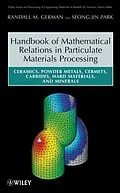The only handbook of mathematical relations with a focus on
particulate materials processing
The National Science Foundation estimates that over 35% of
materials-related funding is now directed toward modeling. In part,
this reflects the increased knowledge and the high cost of
experimental work. However, currently there is no organized
reference book to help the particulate materials community with
sorting out various relations. This book fills that important need,
providing readers with a quick-reference handbook for easy
consultation.
This one-of-a-kind handbook gives readers the relevant
mathematical relations needed to model behavior, generate computer
simulations, analyze experiment data, and quantify physical and
chemical phenomena commonly found in particulate materials
processing. It goes beyond the traditional barriers of only one
material class by covering the major areas in ceramics, cemented
carbides, powder metallurgy, and particulate materials. In many
cases, the governing equations are the same but the terms are
material-specific. To rise above these differences, the authors
have assembled the basic mathematics around the following topical
structure:
* Powder technology relations, such as those encountered in
atomization, milling, powder production, powder characterization,
mixing, particle packing, and powder testing
* Powder processing, such as uniaxial compaction, injection
molding, slurry and paste shaping techniques, polymer pyrolysis,
sintering, hot isostatic pressing, and forging, with accompanying
relations associated with microstructure development and
microstructure coarsening
* Finishing operations, such as surface treatments, heat
treatments, microstructure analysis, material testing, data
analysis, and structure-property relations
Handbook of Mathematical Relations in Particulate Materials
Processing is suited for quick reference with stand-alone
definitions, making it the perfect complement to existing resources
used by academic researchers, corporate product and process
developers, and various scientists, engineers, and technicians
working in materials processing.
Autorentext
Randall M. German, PhD, is the CAVS Chair Professor of
Mechanical Engineering and Director of the Center for Advanced
Vehicular Systems at Mississippi State University. He holds an
Honorary Doctorate from the Universidad Carlos III de Madrid in
Spain, is a Fellow of APMI and ASM, holds the Tesla Medal, and is
listed in various issues of Who's Who. His accomplishments comprise
850 published articles, twenty-three issued patents, nineteen
edited proceedings, and fourteen books, including Sintering
Theory and Practice (Wiley).
Seong Jin Park, PhD, is Associate Research Professor in
the Center for Advanced Vehicular Systems at Mississippi State
University. He is the recipient of numerous awards and honors,
including Leading Scientists of the World and Outstanding
Scientists Worldwide, both awarded by the International
Biographical Centre in 2007. Dr. Park is the author of over 190
published articles and three books, holds four patents, and created
four commercialized software programs. His areas of specialization
and interest include materials processing technology, numerical
technology, and physics.
Zusammenfassung
The only handbook of mathematical relations with a focus on particulate materials processing
The National Science Foundation estimates that over 35% of materials-related funding is now directed toward modeling. In part, this reflects the increased knowledge and the high cost of experimental work. However, currently there is no organized reference book to help the particulate materials community with sorting out various relations. This book fills that important need, providing readers with a quick-reference handbook for easy consultation.
This one-of-a-kind handbook gives readers the relevant mathematical relations needed to model behavior, generate computer simulations, analyze experiment data, and quantify physical and chemical phenomena commonly found in particulate materials processing. It goes beyond the traditional barriers of only one material class by covering the major areas in ceramics, cemented carbides, powder metallurgy, and particulate materials. In many cases, the governing equations are the same but the terms are material-specific. To rise above these differences, the authors have assembled the basic mathematics around the following topical structure:
-
Powder technology relations, such as those encountered in atomization, milling, powder production, powder characterization, mixing, particle packing, and powder testing
-
Powder processing, such as uniaxial compaction, injection molding, slurry and paste shaping techniques, polymer pyrolysis, sintering, hot isostatic pressing, and forging, with accompanying relations associated with microstructure development and microstructure coarsening
-
Finishing operations, such as surface treatments, heat treatments, microstructure analysis, material testing, data analysis, and structure-property relations
Handbook of Mathematical Relations in Particulate Materials Processing is suited for quick reference with stand-alone definitions, making it the perfect complement to existing resources used by academic researchers, corporate product and process developers, and various scientists, engineers, and technicians working in materials processing.
Inhalt
PARTIAL TABLE OF CONTENTS
Foreword.
About the Authors.
A
Abnormal Grain Growth.
Abrasive Wearâ??See Friction and Wear Testing.
Acceleration of Free-settling Particles.
Activated Sintering, Early-stage Shrinkage.
Activation Energyâ??See Arrhenius Relation.
Adsorptionâ??See BET Specific Surface Area.
Agglomerate Strength.
Agglomeration Force.
Agglomeration of Nanoscale Particlesâ??See Nanoparticle Agglomeration.
Andreasen Size Distribution.
B
Ball Millingâ??See Jar Milling.
Bearing Strength.
Bell Curveâ??See Gaussian Distribution.
Bending-beam Viscosity.
Bending Test.
BET Equivalent Spherical-particle Diameter.
BET Specific Surface Area.
Bimodal Powder Packing.
Bimodal Powder Sintering.
Binder Burnoutâ??See Polymer Pyrolysis.
C
Cantilever-beam Testâ??See Bending-beam Viscosity.
Capillarity.
Capillarity-induced Sinteringâ??See Surface Curvature-Driven Mass Flow in Sintering.
Capillary Pressure during Liquid-phase Sinteringâ??See Mean Capillary Pressure.
Capillary Riseâ??See Washburn Equation.
Capillary Stressâ??See Laplace Equation.
Case Carburization.
Casson Model.
Cemented-carbide Hardness.
Centrifugal Atomization Droplet Size.
D
Darcyâ??s Law.
Debindingâ??See Polymer Pyrolysis, Solvent Debinding Time, Thermal Debinding Time, Vacuum Thermal Debinding Time, and Wicking.
Debinding Master Curveâ??See Master Decomposition Curve.
Debinding Temperature.
Debinding Timeâ??See Solvent Debinding Time, Thermal Debinding Time, Vacuum Thermal Debinding Time, and Wicking.
Debinding by Solvent Immersionâ??See Solvent Debinding Time.
Debinding Weight Loss.
Delubricationâ??See Polymer Pyrolysis.
Densification.
Densification in Liquid-phase Sinteringâ??See Dissolution-induced Densification.
E
Effecti…
